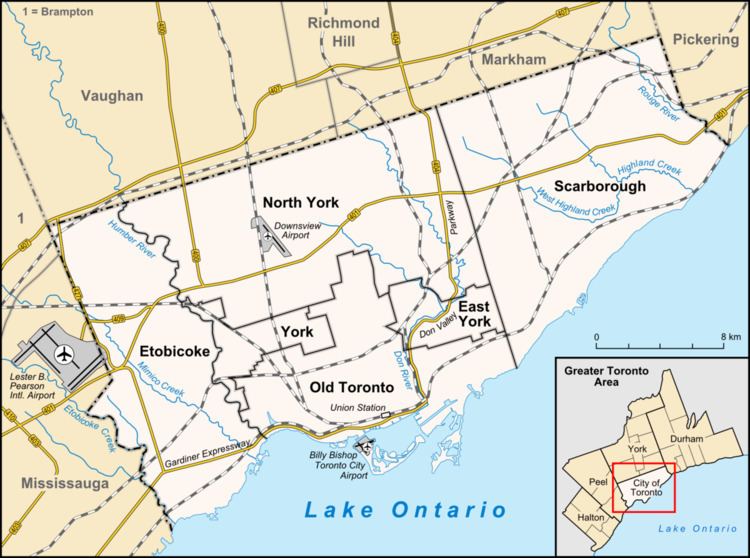Ecclesiastical or organizational status Active Phone +1 416-782-7125 | ||
 | ||
Address 5 Glen Park Ave, North York, ON M6B 4J2, Canada Similar Stashover‑Slipia Congregation, Tiferet Israel Congregation, Adath Israel Congregation, First Narayever Congregation, Kiever Synagogue | ||
Congregation Habonim Toronto, founded in 1954, is a liberal synagogue located at 5 Glen Park Avenue in Toronto, Ontario, Canada, and one of the first Holocaust refugee/survivor congregations to develop in Canada. Although currently independent of any official denomination, its early founders modeled the synagogue on the example of early Reform Judaism in Germany.
Contents
History
The early members of Habonim (literally"the builders") were Holocaust survivors or refugees from Central Europe, who arrived in Canada after World War II.
One of its founders and first President was George Spitz, a Jewish refugee from Berlin, who unsuccessfully attempted to bring over his family from Germany in 1939 on the ill-fated MS St. Louis.
Paul Alexander, also a refugee of Berlin, was an early Vice-President of the synagogue - his twin brother Hanns was most famous for capturing Rudolf Höss, the Kommandant of Auschwitz. Both served as officers in the British Army during World War II and, given their fluency with the German language, were in charge of German POWs at the war's close.
Notable Figures
Some of the notable figures associated with the Congregation are Esther Ghan Firestone, the first female cantor in Canada, Rabbi Reuben Slonim (author, and also associate editor of The Toronto Telegram), known for his outspoken views on the Israeli-Arab conflict, Cantor Henry Weingluck, a well known artist who was a pupil of Max Liebermann, and Avrum Rosensweig, founder of Ve’ahavta, the Canadian Jewish Humanitarian Relief Organization.
The Habonim Youth Choir
The Congregation also supports a choir, the Habonim Youth Choir, whose recording of the peace song Lay Down Your Arms (Doron Levinson song) has received international exposure.
The choir's rendition of Lay Down Your Arms was featured on Fern Levitt's documentary, Gorbachev's Revolution.
Their recording of the Holocaust song, Eli, Eli (lyrics by Hannah Szenes), and "The Song of the Vilna Partisans" (Zog Nit Keyn Mol) appeared on David Kaufman's 2003 documentary, From Despair to Defiance, commemorating the 60th anniversary of the Warsaw Ghetto Uprising. Eli, Eli also appeared on the short documentary "To Live and Die with Honor" commemorating the 70th anniversary of the Warsaw Ghetto Uprising. On May 22, 2014, the Habonim Youth Choir opened up for the legendary Puerto Rican virtuoso blind guitarist & singer, Jose Feliciano, at a Benefit Concert for the Canadian Friends of the Israel Guide Dog Centre for the Blind at the Toronto Centre for the Arts.
2015 Recording of “Lay Down Your Arms”:
To mark the 70th anniversary of the end of World War II in Europe, the Habonim Youth Choir and the March of the Living Children’s Choir, recorded a new version of “Lay Down Your Arms”. Cantor Aviva Rajsky and guitarist Tom Bellman - from Toronto’s Congregation Habonim - composed a new arrangement for the song. It was first performed on Holocaust Remembrance Day, at the 2015 March of the Living ceremony in Auschwitz-Birkenau.
Partnership with Other Organizations
The synagogue makes its facilities available to a number of other organizations, including Ve’ahavta, co-sponsoring a Passover Seder for the Homeless every year and the Toronto Partnership Minyan, an Orthodox egalitarian initiative in Toronto spearheaded by Professor Martin Lockshin, and has co-sponsored events with other organizations outside the Jewish community such as Free the Children and Me to We, producing a joint event featuring the Kenyan Boys Choir.
It is also home to Canada's only multi-denominational introductory conversion course.
Synagogue Interior
The synagogue windows are made of stained glass created by modern-day master Gerald Tooke (1931-2011), considered among Canada's leading practitioners of the craft. His work may also be seen at Mount Allison University Chapel in Sackville, N.B, Ontario's legislative buildings in Toronto, and in many churches and other buildings across Canada, said to number around 100 in all.
The distinctive ark was designed by celebrated Canadian sculptor May Marx. The ark was manufactured and installed by longtime synagogue member Alfred Altman, himself a refugee from Düsseldorf Germany. While he escaped Düsseldorf on the Kindertransport in 1939, both his parents were murdered in the Holocaust and now have Stolperstein monuments placed in their memory in front of their former home.
